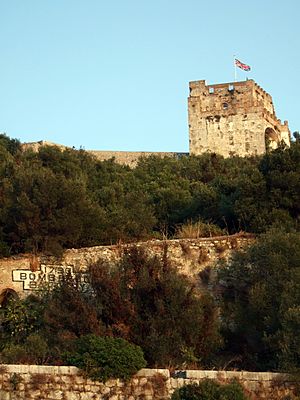Tariq ibn Ziyad facts for kids
Quick facts for kids
Ṭāriq ibn Ziyād
طارق بن زياد |
|
|---|---|
| Allegiance | Umayyad Caliphate |
| Battles/wars | Conquest of Hispania • Battle of Guadalete |
| Other work | Governor of Tangier Governor of Al-Andalus |
Ṭāriq ibn Ziyād (Arabic: طارق بن زياد), also known as Tarik, was a brave Berber commander. He worked for the Umayyad Caliphate, which was a large Muslim empire. Ṭāriq is famous for starting the Muslim conquest of Visigothic Hispania (which is now Spain and Portugal) in the years 711–718 AD.
He led his army across the Strait of Gibraltar from North Africa. His troops gathered at a large rock that is now called the Rock of Gibraltar. The name "Gibraltar" comes from the Arabic name Jabal Ṭāriq, which means "mountain of Ṭāriq". It was named after him!
Who Was Ṭāriq?
Historians from long ago have different ideas about where Ṭāriq came from. But most modern experts agree that Ṭāriq was a Berber. He was a trusted helper and leader for Musa ibn Nusayr, who was the Umayyad governor of a region called Ifriqiya. It is believed that Ṭāriq was born in the Tlemcen area and lived there with his wife before he became governor of Tangier.
The Conquest of Hispania

After the city of Tangier was conquered around 710-711, Musa ibn Nusayr made Ṭāriq its governor. However, there was still a part of the Visigothic kingdom nearby that had not been conquered. This was a strong fort called Ceuta, led by a nobleman named Julian, Count of Ceuta.
The king of Spain at that time was Roderic. Count Julian made a secret agreement with Ṭāriq. Julian owned many ships and forts on the Spanish mainland. He agreed to help Ṭāriq's army cross the Strait of Gibraltar.
Around April 26, 711, Ṭāriq's army landed on the Iberian Peninsula (which is now Spain). Most of his soldiers were Berbers who had recently become Muslim. They landed at the foot of a mountain, which was then named Gibraltar (Jabal Tariq) after him.
The Battle of Guadalete
Ṭāriq's army had about 7,000 soldiers. King Roderic gathered a much larger army to fight them. On July 19, Ṭāriq won a huge victory at the Battle of Guadalete. King Roderic was defeated and killed.
After this important victory, Ṭāriq split his army into four groups. These groups went on to capture important cities like Córdoba, Granada, and Toledo. Ṭāriq himself led the group that captured Toledo. He continued to advance north, reaching cities like Guadalajara and Astorga.
Ṭāriq was the main leader in Hispania until Musa arrived a year later. Musa then brought more troops. Within a few years, Ṭāriq and Musa had conquered a large part of the Iberian Peninsula from the Visigoths.
Later Life
In 714, the Umayyad Caliph Al-Walid I ordered both Ṭāriq and Musa to return to Damascus. They spent the rest of their lives there. There are different stories from old historians about how Ṭāriq and Musa got along. Some say Musa was angry and jealous of Ṭāriq's success. Others say they were friendly. One historian, al-Baladhuri, wrote that Musa sent Ṭāriq a "severe letter," but they later made up.
See also
 In Spanish: Táriq ibn Ziyad para niños
In Spanish: Táriq ibn Ziyad para niños

